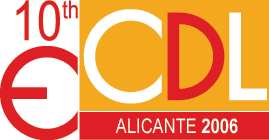
Bringing Digital Libraries to Distributed Infrastructures:
Challenges, Solutions, and Lessons Learned
Presenters' name:
Yannis Ioanidis (University of Athens, Greece), Carlo Meghini (CNR-ISTI, Italy), Heiko Schuldt (University of Basel, Switzerland).
Abstract
Current plans for next generation DL architectures are aiming for a transition from the DL as an integrated, centrally controlled system to a dynamic configurable federation of DL services and information collections. The transition is driven by DL "market" needs and inspired by new technology trends that promise to solve at least part of these market needs.
With the uptake of DLs in a wider community there is a need for better and adaptive tailoring of the content and service offer of a DL to the needs of the respective community as well as to the current service and content offer. Furthermore, there is a need for more systematic exploitation of existing resources like information collections, metadata collections, services, and computational resources for making DLs more cost-effective as well as a need for opening up of DL technology to a wider clientele by enabling more cost-effective digital libraries.
New technologies like Web services and Grid infrastructures and new paradigms like Peer-to-Peer networking and Service-oriented Architectures (SOA) suggest digital libraries that operate on more demand-oriented and flexible distributed or decentralized infrastructures.
The tutorial aims to introduce to the audience various central aspects of bringing digital libraries to distributed infrastructures and to suggest concrete solutions for the upcoming challenges. For this purpose, the tutorial looks at the issue from a very pragmatic point of view. The tutorial discusses the core ideas of building digital libraries on distributed infrastructures and the related architectural options. Furthermore, it introduces the underlying technologies as a foundation for the understanding of the concrete solutions. The main part of the tutorial revolves around the following core DL topics:
- Digital Library Management
- Content and Collection Management
- Metadata Management and Brokering
- Search and Retrieval " Advanced Services (Personalization, Annotation, etc.)
For each of the topics the key challenges are discussed together with possible solutions for the challenges and the lessons learned in implementing these solutions in concrete projects. The solutions are illustrated with concrete examples and small system demos from the projects DILIGENT, BRICKS, and DELOS as well as from other DL-related projects.
Contents
- Introduction:
Distributed Infrastructures for Digital Libraries
This part of the tutorial gives an introduction to the area of building digital libraries on top of distributed infrastructures. It starts with a discussion of the rationale for going towards next generation digital library architectures by considering a mixed technology push - market pull perspective. Furthermore, this part of the tutorial discusses architectural alternatives and promising reference architectures for the construction of next generation digital libraries.
- Underlying
Technologies and their Promises
In this part, the technologies underlying the new distributed digital library architectures are presented. This includes: Service-oriented Architectures, Grid Infrastructures, Peer to Peer Infrastructures
For each of these technologies, the core concepts and promises behind the respective technology, its implementation status, related standards, and the main applications are discussed. In addition to the general technology promises, the tutorial will also examines the special promises of the technology in the digital library context. Of course, a full coverage of each of these technologies is beyond the scope of this tutorial. For this purpose pointers to further readings are also given as part of the presentation to interested participants. - Challenges
and Solutions for DL Functionality in Decentralized Infrastructures
This part forms the core of the tutorial. It looks into concrete solutions for dedicated digital library topics when migrating from centralized systems to flexible service federations. The following five important digital library topics will be considered in separate blocks:
- Digital Library Management
- Content and Collection Management
- Metadata Management and Brokering
- Search and Retrieval
- Advanced Services (Personalization, Annotation, etc.)
For each of the above topics, the challenges raised by distributed infrastructures for the respective functionality are discussed. Based on the experiences gathered in the projects DILIGENT, BRICKS and DELOS as well as in other digital library related projects exemplary solutions are presented for each of the topics. These solutions are illustrated by small system demonstration, wherever possible. Finally, a compilation of lessons learned aims to provide practitioners with further valuable insights from the project work.
- Conclusions and
Open Issues
This part of the tutorial gives a short summary of the tutorial content and tries to draw useful conclusions from the lessons learned in the different projects as well as from the comparison of the solutions employed in the individual projects. Furthermore, it points out some open issues that raise from the setting and operating digital libraries on top of distributed infrastructures. This includes technical as well as organizational challenges as they raise for example from the long-term operation of a flexible service infrastructure in a dynamic and autonomous environment.
Copyright ECDL - Design by JASBAT
